
1930s Art Deco Walnut Sideboard with Tambour Doors and Glass
An Art Deco walnut sideboard, circa 1930s with a slightly recessed upper section with curved ends, the central drop front glazed section with mirror back and glass shelves, flanked by tambour sliding cupboard doors, the lower section with central twin…
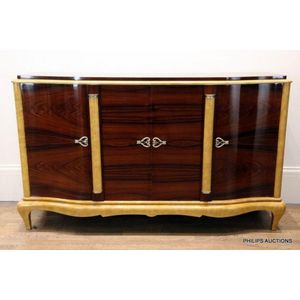
Art Deco Brazilian Rosewood and Sycamore Sideboard, Circa 1940
A superb Art Deco Brazilian rosewood and sycamore sideboard, circa 1940 . The sideboard in the style of Jules Leleu, rectangular with a slightly curved front, above well-figured Brazilian rosewood central cupboards flanked by contrasting half columns and…
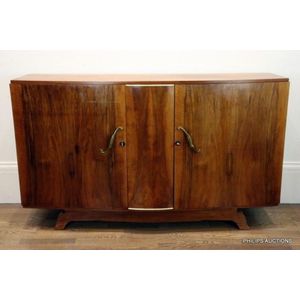
French Art Deco Walnut Sideboard with Brass Handles, 1930s
A French Art Deco walnut sideboard, circa 1930s the plain top of gently bow front form, above cupboard doors with brass oblique scroll handles, the interior fitted with internal shelves, raised on an elongated base with splayed feet. Height 94 cm, width…

1930s Art Deco Walnut Inlaid Sideboard with Floral Detailing
An Art Deco walnut inlaid sideboard, circa 1930s the long gently bowed front form, with two double cupboard doors finely line strung and inlaid with restrained floral detailing, raised upon a plinth base with wedge feet, with original keys. Height 98 cm,…

Art Deco Macassar Ebony Sideboard with Bronze Features, Melbourne 1980s
In the style of Emile Jacques Ruhlmann (French, 1879-1933) sideboard, Art Deco sideboard, of macassar ebony veneer, with four doors, nickel plated bronze features, two cutlery drawers, three adjustable shelves, with black base, this version was produced…

1935 Art Deco Rosewood Sideboard with Oriental Brass Handles
An Art Deco rosewood sideboard, circa 1935, the two door sideboard with an oriental inspired brass handle feature, rounded edges and an ebonised border above a plinth base, with key, 94.5 cm high, 180 cm wide, 48 cm deep
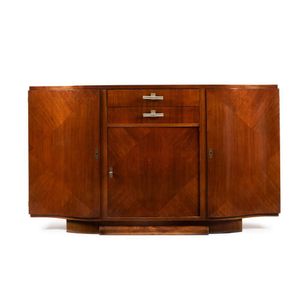
French Art Deco Palisander Sideboard, Circa 1930
A French Art Deco palisander sideboard with serpentine front, circa 1930, 104 cm high, 180 cm wide, 50 cm deep

Art Deco Sideboard with Karelian Birch and Macassar Ebony
An Austrian Art Deco sideboard, Karelian birch and macassar ebony with black marble top and ivorine handles, circa 1925, 93 cm high, 107 cm wide, 37 cm deep
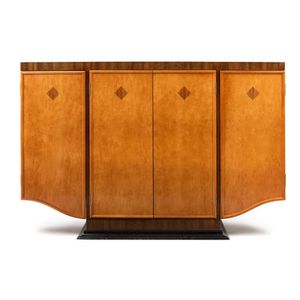
Austrian Art Deco Palisander Sideboard, 1925
An Austrian Art Deco four door sideboard, palisander and birch, circa 1925, 92 cm high, 137 cm wide, 45 cm deep

Art Deco Mahogany Sideboard by Gaston Poisson
A French Art Deco mahogany sideboard by Gaston Poisson, circa 1930s, the sideboard front with four framed doors surrounding geometric medallions and diamond patterns in exotic woods, the interior enclosing single shelves and single drawers to the side…

French Art Deco Figured Walnut Sideboard with Upstand
A quality French Art Deco figured walnut designer sideboard, the upstand back with curved bars raised on ebonised balls, the rosewood cross banded base with four doors above three drawers, on tapered platform base. A good example. 176 x 60 x 133 cm.

Art Deco Rosewood Sideboard with Mini Bar
A French Art Deco rosewood and sycamore sideboard, circa 1935, the elegant sideboard standing on splayed bracket feet with shaped apron, the rectangular carcass with a graduated side extension supporting two side doors with Celtic design escutcheons, with…
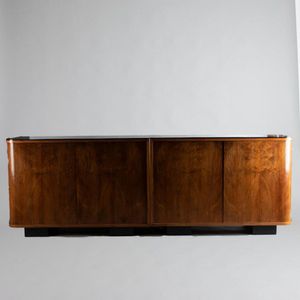
Viennese Art Deco Walnut Sideboard with Black Glass Tops
A Viennese Art Deco walnut sideboard, comprises two sideboards that sit together, with black glass tops on black lacquered legs, height 90 cm, width 260 cm, diameter 55 cm

Palisander Art Deco Sideboard with Mini Bar
An Art Deco palisander veneer sideboard, circa 1930, France, the sideboard in the manner of Leleu with two side doors and a feature central door that swivels to reveal a mini bar, with a faux leather green trim, height 100 cm, width 210 cm depth 49 cm

Art Deco Sideboard, c.1930
A stunning Art Deco sideboard, c.1930. Sloping, curved sides with two drawers to each. Height 130 cm, width 144 cm, diameter 58 cm

1930s Art Deco Walnut Sideboard with Marble Top
An Art Deco walnut sideboard, circa 1930s, the two tier sideboard with a grey striped cream marble top above a pair of glazed cupboards with lower convex drawers flanked by side cabinets with burr walnut veneer fronts and curved lower sides, raised on a…

Art Deco Macassar Ebony Sideboard with Marble Top
A large Art Deco Macassar ebony sideboard, circa 1930, the whole veneered in macassar ebony, with ebonised features, the rectangular inset portoro marble plate top (in two pieces), above five small drawers with nickel plate handles, flanked by large doors…

Macassar Ebony Art Deco Sideboard with Marble Top
An Art Deco Macassar ebony sideboard, circa 1930, the whole veneered in macassar ebony, with ebonised features, the rectangular inset portoro marble plate top, above a pair of doors enclosing shelves, raised on a plinth base, 96 cm high, 140 cm wide, 44.5…

Art Deco Walnut Sideboard with Floral Decoration
An Art Deco walnut sideboard, matching above, a central mirrored and glass door compartment to the centre with a drawer to each side, over four cupboard doors, raised on stepped plinth base, restrained floral decoration. 183 cm x 56 cm x 97 cm.
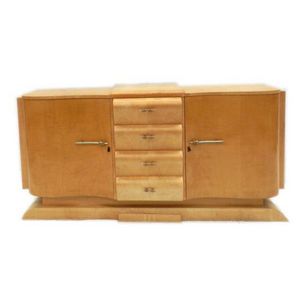
Art Deco Sycamore Veneer Sideboard by Edward Hill, Melbourne
An Art Deco sycamore veneer sideboard, Edward hill, Melbourne, two doors, four drawers, with original Bakelite & chrome handles, 93 x 187 x 54 cm
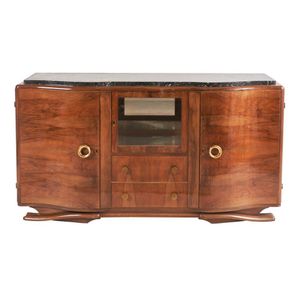
French Art Deco Marble Sideboard with Glazed Central Door
A French Art Deco sideboard, circa 1940, of generous proportions, with a marble plate, comprising two doors flanking two drawers and a glazed central door.

French Art Deco Rosewood Sideboard with Inlays and Marble Top
A French Art Deco sideboard, rosewood inlaid with ivory, ebony and mother of pearl with vert marble top, circa 1925, 100 cm high, 194 cm wide, 59 cm deep

Art Deco Rosewood Sideboard with Harlequin Diamond Design
An Art Deco rosewood four door sideboard, circa 1935, with a central pair of framed harlequin diamond parquetry cupboard doors, flanked by gently bowed side doors fitted with a single drawer and shelf, a shaped apron and raised on substantial tapering…

French Art Deco Rosewood Sideboard
French Art Deco sideboard, c. 1930, in the style of Maurice Rinck, rosewood and nickelled bronze trim and pulls, of rectangular form, with a single glass door flanked by cupboard doors enclosing shelves, height 102 cm width 200 cm depth 47 cm. Provenance:…

French Art Deco Rosewood Sideboard, c. 1930
French Art Deco sideboard, c. 1930, in the style of Maurice Rinck, rosewood and chromed metal, of rectangular form with bow front, the marble top over a pair of doors flanked by cupboard doors, height 91 cm width 221 cm depth 48 cm. Provenance: Private…

Art Deco Walnut and Parchment Sideboard by Dominique
Dominique (French, 1922-1970), Art Deco sideboard, c. 1930, walnut and parchment, of rectangular form with bow front, the tiered top over five drawers flanked by two doors enclosing shelves, raised on plinth base with bracket feet, height 97 cm width 191…
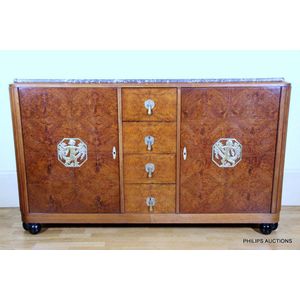
Art Deco Mahogany Sideboard with Bronze Ornaments
A fine Art Deco sideboard in mahogany and burr timbers, circa 1930, a mottled grey marble top above four central drawers with brass pull handles and circular backplates, flanked by two cupboards with tiled burr panels centred with striking framed cast…

Art Deco Continental Sideboard in Amboyna and Walnut
A continental amboyna and walnut Art Deco sideboard. 90 cm high, 93 cm wide, 40 cm deep.

Art Deco Maple Sideboard with Glass Top
An Art Deco fiddle back Queensland maple sideboard, circa 1930s, with bevelled glass top the top, the vigorously figured sideboard of shaped profile with a slightly raised central section, four cushion profile drawers flanked by fitted cupboards above a…

French Art Deco Rosewood Sideboard, 1940s
A French Art Deco rosewood sideboard, circa 1940's, the sideboard with a striking parquetry panel to the top above four cupboards, the central recessed pair of conforming design with a decorative cast hinge flanked by cupboards with serpentine profiles,…

French Art Deco Rosewood Sideboard with Figural Inlay
Most impressive French Art Deco period inlaid rosewood four door sideboard, fitted with a central figural inlaid panel, approx 92.5 cm high, 230 cm wide, 55 cm deep
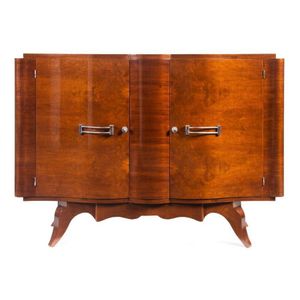
French Art Deco Walnut Sideboard, Circa 1930
A French Art Deco walnut sideboard, Circa 1930. 100 cm high, 141 cm wide, 47 cm deep.

French Art Deco Rosewood Buffet with Marble Top
A French rosewood Art Deco buffet, circa 1930, the buffet with a black and white striated marble top, and a stepped cornice above a curved front, a pair of doors and two small drawers with large circular chrome knobs and a central glazed door above a…

Macassar Art Deco Sideboard with Fan Features
A striking Macassar sideboard with Art Deco Styling, circa 1960, the sideboard having a pair of central doors each with Macassar striped panels flanked by two side cupboards with dramatic fan like features within shaped satin wood strung reserves, the…

Walnut Art Deco Sideboard with Marble Top
French Art Deco walnut sideboard of stepped design with marble top, approx 175 cm high, 160 cm wide, 50 cm deep

French Art Deco Lacquer Sideboard with Chrome Mounts
A French fine quality polished lacquer Art Deco three door sideboard, chrome metal mounts, fitted drawers, approx 94 cm high, 199 cm wide, 52 cm deep

French Art Deco Mahogany Marble Sideboard
French Art Deco Mahogany and marble sideboard, fitted with glazed two door upper section and door cupboards below, bronze handles, approx 106 cm high, 132 cm wide

French Art Deco Mahogany Sideboard with Marble Top
French Art Deco Mahogany marble topped sideboard, fitted with bronze handles, approx 160 cm high, 202 cm wide

Art Deco Marble Top Break-Front Sideboard
An Art Deco marble topped break-front sideboard, possibly Kingwood, French circa 1940, 102 cm high, approx. 215 cm wide, 52 cm deep

Art Deco Rosewood Sideboard by Kafka
Art Deco rosewood veneered sideboard attributed to Kafka three central drawers with two cutlery drawers 168 cm wide 96 cm height 51 cm depth

Art Deco Walnut Sideboard
A walnut Art Deco sideboard, circa 1925, of gently shaped bow front form, with panel style and reeded curved side doors flanking a bank of four vertical drawers, and upon a quarter circle plinth base. Height 106 cm. Width 187 cm. Depth 65 cm.

French Art Deco Walnut Sideboard with Marble and Mirror
A French Art Deco figured walnut bow-front sideboard, 1930s, the mottled grey and white marble-lined inverted break-top with a shaped mirror back with chromed supports above a central frieze drawer and cabinet door flanked by a pair of curved cabinet…

Geometric Art Deco Sideboard
Art deco sideboard 2 doors & 2 drawers, with geometric inlay, 137 cm wide, 105 cm high

French Art Deco Rosewood Sideboard with Aquatic Inlay
A striking French rosewood Art Deco sideboard, circa 1950, a parquetry top above a central cupboard inlaid with mermaids and aquatic motifs, flanked by two double doors covered in cream leatherette opening to beautifully lined and fitted cupboards, upon…

Art Deco Walnut Sideboard with Bold Carvings and Marble Top
A French walnut and burr veneer Art Deco sideboard, circa 1920s, a recessed three door cabinet, the central glazed door with boldly carved fruit, nuts, flora and wheat motifs, elevated on carved and scroll legs above a mirrored back and a shaped black…

French Art Deco Sideboard with Glazed Center Door
A good French Art Deco sideboard, central glazed door surrounded by two cabinet doors, black marble top marble restored

Art Deco Rosewood Sideboard with Leather and Brass Details
A French Art Deco rosewood sideboard, circa 1930-1940, of rectilinear bowed form, four doors opening to a satinwood lined interior with single shelving, two drawers enclosed centrally within reverse opening doors, a brass cartouche with tooled leather as…

Art Deco Marble Top Sideboard with Tropical Foliage Relief
An Art Deco marble topped walnut sideboard, circa 1930s, mirror backed and slightly bow fronted, two fluted frieze drawers with triangular drop metal handles, the two cupboard doors below with geometric pull handles and a vertical panel in low relief with…

Art Deco Walnut Sideboard with Marble Top
An Art Deco walnut and marble topped sideboard, circa 1930s, mirror backed and slightly bow fronted, two fluted side drawers with triangular drop metal handles, the two cupboard doors below with geometric pulls, each door carved in low relief with a band…


 Loading more...
Loading more...